Surveying Report: Field Measurement, Data Analysis, and Applications
VerifiedAdded on 2023/04/22
|8
|1546
|337
Report
AI Summary
This report details a surveying exercise involving pace calibration, traverse pacing, differential leveling, circuit adjustment, and horizontal distance and angle measurements using a total station. The surveying labs aimed to determine elevations, distances, and angles for a specific plot of land. The pace calibration lab determined the length of each group member's pace to estimate traverse length, while differential leveling determined adjusted elevations of traverse points. The total station lab focused on determining traverse side lengths and internal angles. The report concludes that surveying is crucial for civil engineering, enabling accurate distance, elevation, and angle determination before commencing any civil work. Desklib offers similar reports and study tools for students.
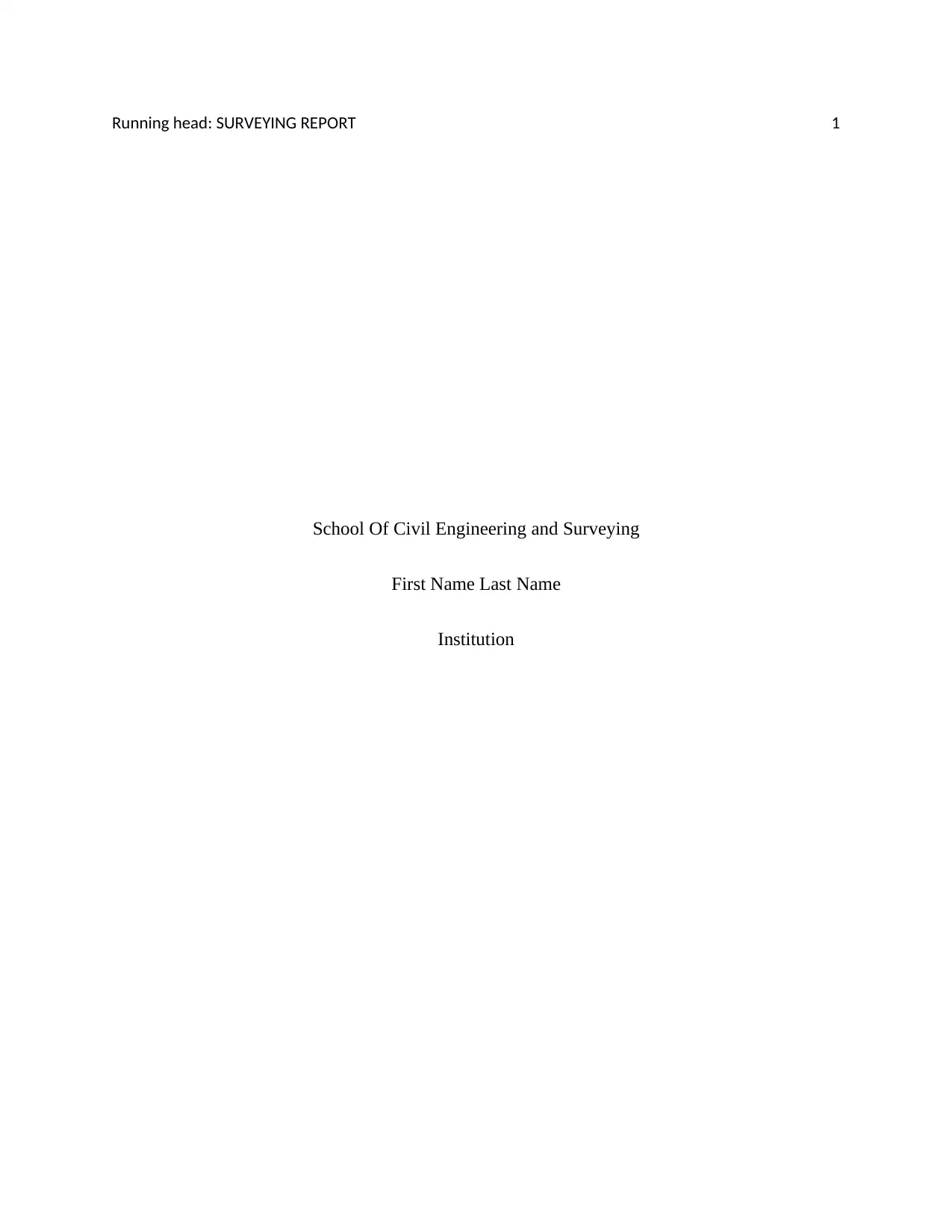
Running head: SURVEYING REPORT 1
School Of Civil Engineering and Surveying
First Name Last Name
Institution
School Of Civil Engineering and Surveying
First Name Last Name
Institution
Paraphrase This Document
Need a fresh take? Get an instant paraphrase of this document with our AI Paraphraser
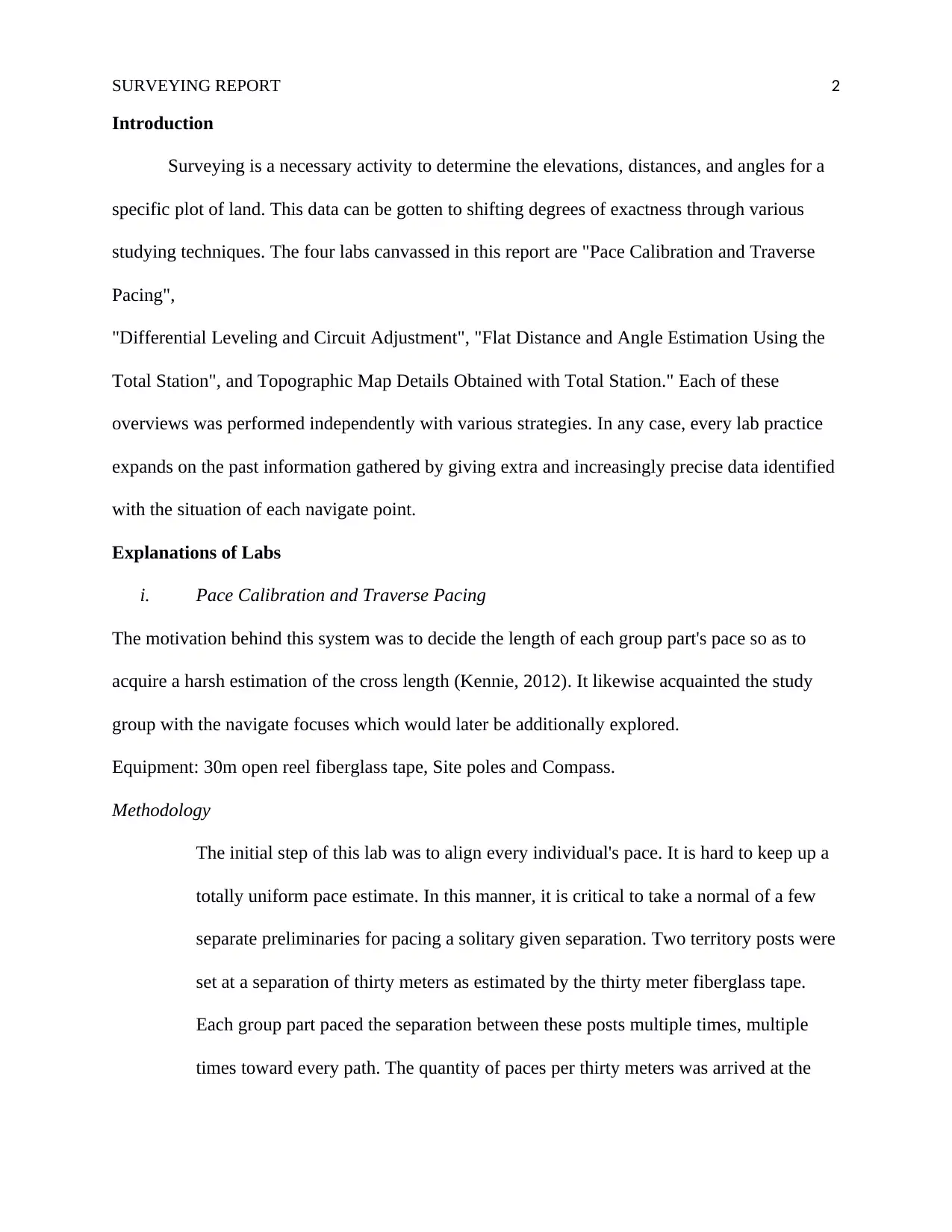
SURVEYING REPORT 2
Introduction
Surveying is a necessary activity to determine the elevations, distances, and angles for a
specific plot of land. This data can be gotten to shifting degrees of exactness through various
studying techniques. The four labs canvassed in this report are "Pace Calibration and Traverse
Pacing",
"Differential Leveling and Circuit Adjustment", "Flat Distance and Angle Estimation Using the
Total Station", and Topographic Map Details Obtained with Total Station." Each of these
overviews was performed independently with various strategies. In any case, every lab practice
expands on the past information gathered by giving extra and increasingly precise data identified
with the situation of each navigate point.
Explanations of Labs
i. Pace Calibration and Traverse Pacing
The motivation behind this system was to decide the length of each group part's pace so as to
acquire a harsh estimation of the cross length (Kennie, 2012). It likewise acquainted the study
group with the navigate focuses which would later be additionally explored.
Equipment: 30m open reel fiberglass tape, Site poles and Compass.
Methodology
The initial step of this lab was to align every individual's pace. It is hard to keep up a
totally uniform pace estimate. In this manner, it is critical to take a normal of a few
separate preliminaries for pacing a solitary given separation. Two territory posts were
set at a separation of thirty meters as estimated by the thirty meter fiberglass tape.
Each group part paced the separation between these posts multiple times, multiple
times toward every path. The quantity of paces per thirty meters was arrived at the
Introduction
Surveying is a necessary activity to determine the elevations, distances, and angles for a
specific plot of land. This data can be gotten to shifting degrees of exactness through various
studying techniques. The four labs canvassed in this report are "Pace Calibration and Traverse
Pacing",
"Differential Leveling and Circuit Adjustment", "Flat Distance and Angle Estimation Using the
Total Station", and Topographic Map Details Obtained with Total Station." Each of these
overviews was performed independently with various strategies. In any case, every lab practice
expands on the past information gathered by giving extra and increasingly precise data identified
with the situation of each navigate point.
Explanations of Labs
i. Pace Calibration and Traverse Pacing
The motivation behind this system was to decide the length of each group part's pace so as to
acquire a harsh estimation of the cross length (Kennie, 2012). It likewise acquainted the study
group with the navigate focuses which would later be additionally explored.
Equipment: 30m open reel fiberglass tape, Site poles and Compass.
Methodology
The initial step of this lab was to align every individual's pace. It is hard to keep up a
totally uniform pace estimate. In this manner, it is critical to take a normal of a few
separate preliminaries for pacing a solitary given separation. Two territory posts were
set at a separation of thirty meters as estimated by the thirty meter fiberglass tape.
Each group part paced the separation between these posts multiple times, multiple
times toward every path. The quantity of paces per thirty meters was arrived at the
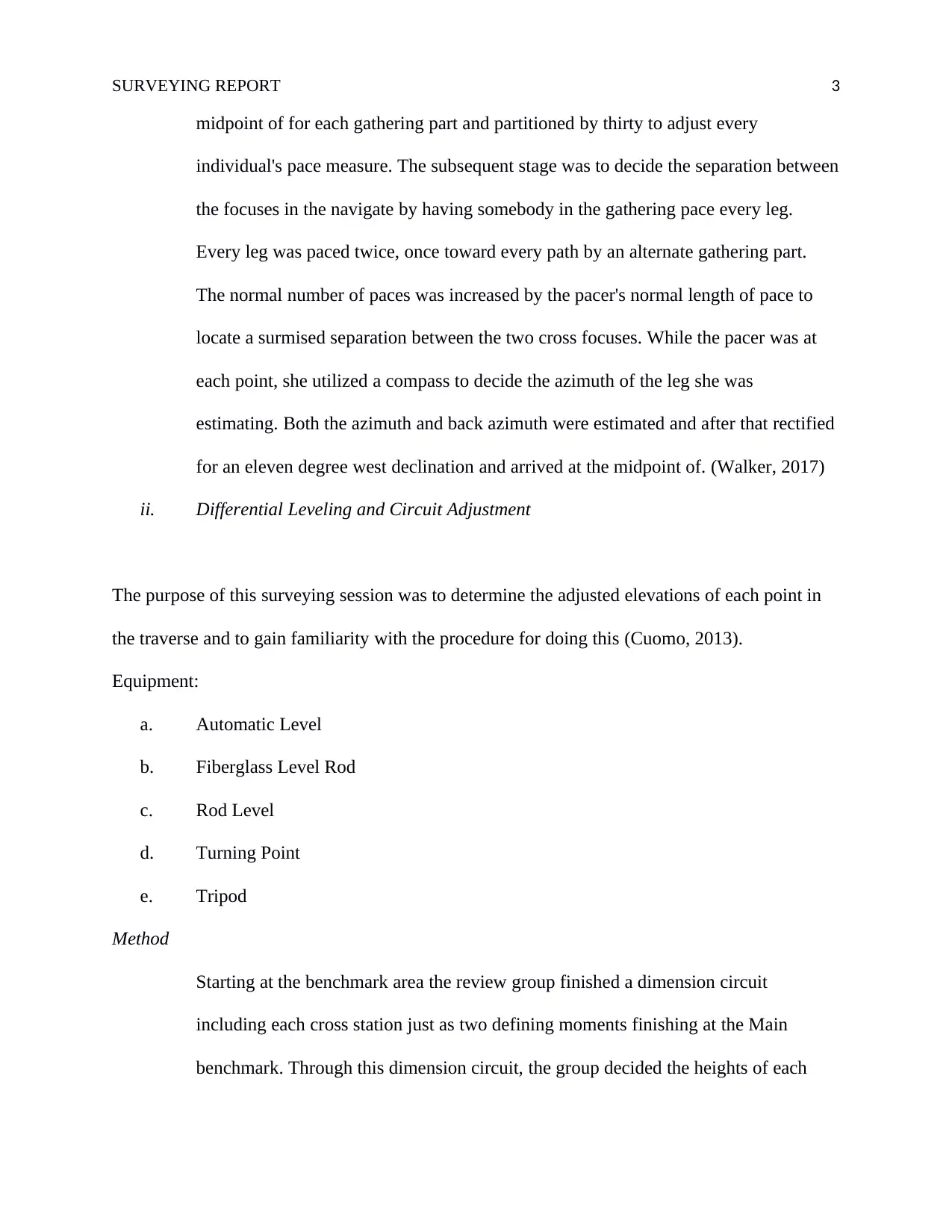
SURVEYING REPORT 3
midpoint of for each gathering part and partitioned by thirty to adjust every
individual's pace measure. The subsequent stage was to decide the separation between
the focuses in the navigate by having somebody in the gathering pace every leg.
Every leg was paced twice, once toward every path by an alternate gathering part.
The normal number of paces was increased by the pacer's normal length of pace to
locate a surmised separation between the two cross focuses. While the pacer was at
each point, she utilized a compass to decide the azimuth of the leg she was
estimating. Both the azimuth and back azimuth were estimated and after that rectified
for an eleven degree west declination and arrived at the midpoint of. (Walker, 2017)
ii. Differential Leveling and Circuit Adjustment
The purpose of this surveying session was to determine the adjusted elevations of each point in
the traverse and to gain familiarity with the procedure for doing this (Cuomo, 2013).
Equipment:
a. Automatic Level
b. Fiberglass Level Rod
c. Rod Level
d. Turning Point
e. Tripod
Method
Starting at the benchmark area the review group finished a dimension circuit
including each cross station just as two defining moments finishing at the Main
benchmark. Through this dimension circuit, the group decided the heights of each
midpoint of for each gathering part and partitioned by thirty to adjust every
individual's pace measure. The subsequent stage was to decide the separation between
the focuses in the navigate by having somebody in the gathering pace every leg.
Every leg was paced twice, once toward every path by an alternate gathering part.
The normal number of paces was increased by the pacer's normal length of pace to
locate a surmised separation between the two cross focuses. While the pacer was at
each point, she utilized a compass to decide the azimuth of the leg she was
estimating. Both the azimuth and back azimuth were estimated and after that rectified
for an eleven degree west declination and arrived at the midpoint of. (Walker, 2017)
ii. Differential Leveling and Circuit Adjustment
The purpose of this surveying session was to determine the adjusted elevations of each point in
the traverse and to gain familiarity with the procedure for doing this (Cuomo, 2013).
Equipment:
a. Automatic Level
b. Fiberglass Level Rod
c. Rod Level
d. Turning Point
e. Tripod
Method
Starting at the benchmark area the review group finished a dimension circuit
including each cross station just as two defining moments finishing at the Main
benchmark. Through this dimension circuit, the group decided the heights of each
⊘ This is a preview!⊘
Do you want full access?
Subscribe today to unlock all pages.

Trusted by 1+ million students worldwide
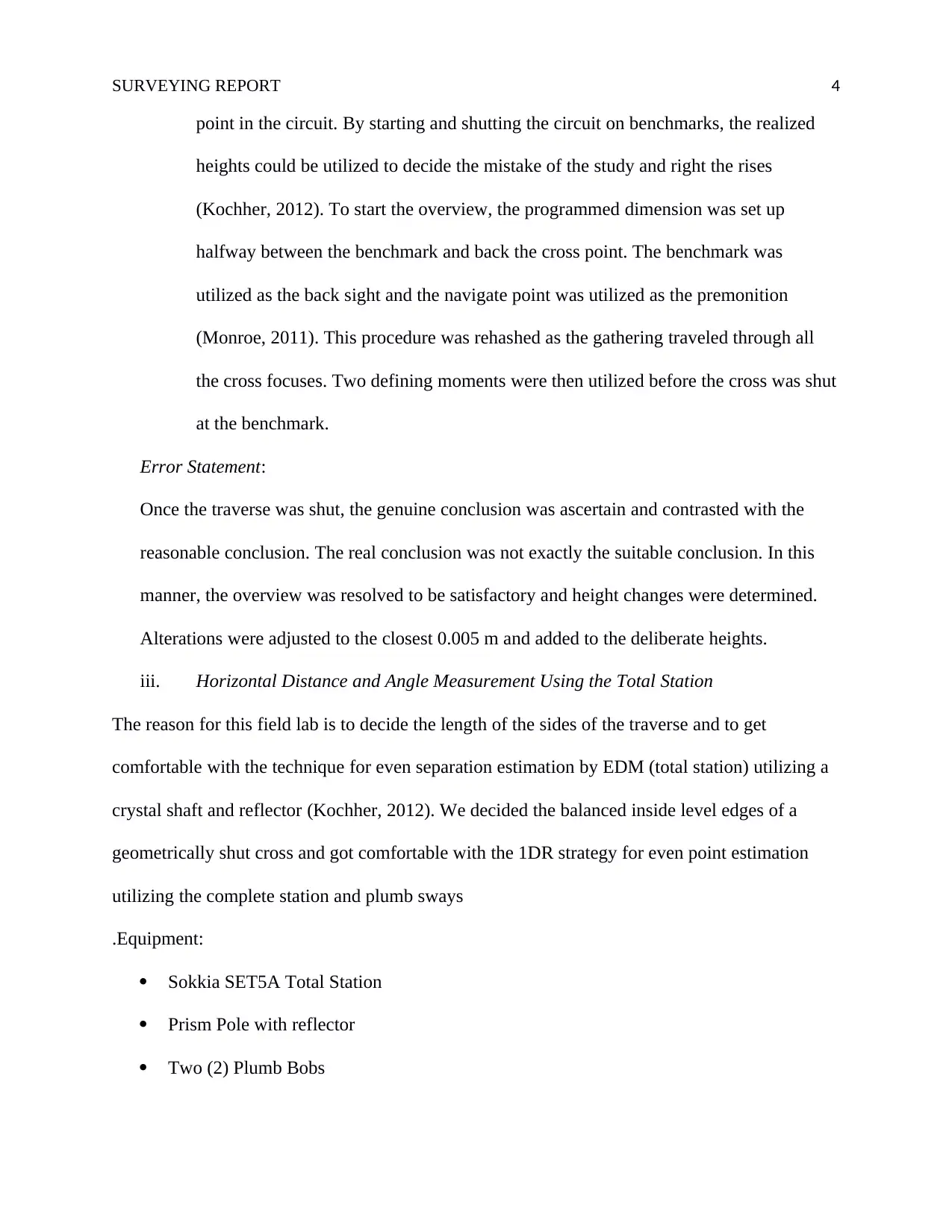
SURVEYING REPORT 4
point in the circuit. By starting and shutting the circuit on benchmarks, the realized
heights could be utilized to decide the mistake of the study and right the rises
(Kochher, 2012). To start the overview, the programmed dimension was set up
halfway between the benchmark and back the cross point. The benchmark was
utilized as the back sight and the navigate point was utilized as the premonition
(Monroe, 2011). This procedure was rehashed as the gathering traveled through all
the cross focuses. Two defining moments were then utilized before the cross was shut
at the benchmark.
Error Statement:
Once the traverse was shut, the genuine conclusion was ascertain and contrasted with the
reasonable conclusion. The real conclusion was not exactly the suitable conclusion. In this
manner, the overview was resolved to be satisfactory and height changes were determined.
Alterations were adjusted to the closest 0.005 m and added to the deliberate heights.
iii. Horizontal Distance and Angle Measurement Using the Total Station
The reason for this field lab is to decide the length of the sides of the traverse and to get
comfortable with the technique for even separation estimation by EDM (total station) utilizing a
crystal shaft and reflector (Kochher, 2012). We decided the balanced inside level edges of a
geometrically shut cross and got comfortable with the 1DR strategy for even point estimation
utilizing the complete station and plumb sways
.Equipment:
Sokkia SET5A Total Station
Prism Pole with reflector
Two (2) Plumb Bobs
point in the circuit. By starting and shutting the circuit on benchmarks, the realized
heights could be utilized to decide the mistake of the study and right the rises
(Kochher, 2012). To start the overview, the programmed dimension was set up
halfway between the benchmark and back the cross point. The benchmark was
utilized as the back sight and the navigate point was utilized as the premonition
(Monroe, 2011). This procedure was rehashed as the gathering traveled through all
the cross focuses. Two defining moments were then utilized before the cross was shut
at the benchmark.
Error Statement:
Once the traverse was shut, the genuine conclusion was ascertain and contrasted with the
reasonable conclusion. The real conclusion was not exactly the suitable conclusion. In this
manner, the overview was resolved to be satisfactory and height changes were determined.
Alterations were adjusted to the closest 0.005 m and added to the deliberate heights.
iii. Horizontal Distance and Angle Measurement Using the Total Station
The reason for this field lab is to decide the length of the sides of the traverse and to get
comfortable with the technique for even separation estimation by EDM (total station) utilizing a
crystal shaft and reflector (Kochher, 2012). We decided the balanced inside level edges of a
geometrically shut cross and got comfortable with the 1DR strategy for even point estimation
utilizing the complete station and plumb sways
.Equipment:
Sokkia SET5A Total Station
Prism Pole with reflector
Two (2) Plumb Bobs
Paraphrase This Document
Need a fresh take? Get an instant paraphrase of this document with our AI Paraphraser
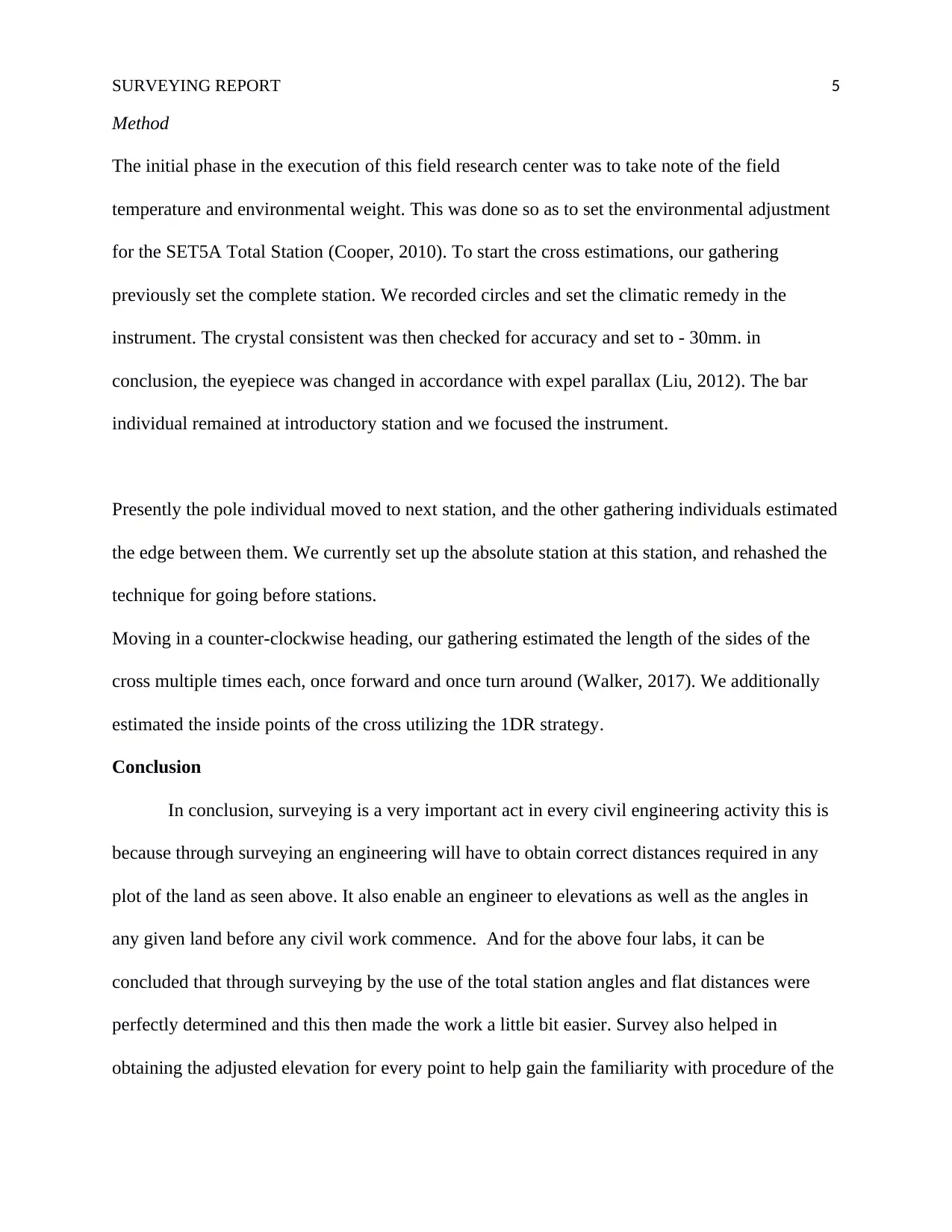
SURVEYING REPORT 5
Method
The initial phase in the execution of this field research center was to take note of the field
temperature and environmental weight. This was done so as to set the environmental adjustment
for the SET5A Total Station (Cooper, 2010). To start the cross estimations, our gathering
previously set the complete station. We recorded circles and set the climatic remedy in the
instrument. The crystal consistent was then checked for accuracy and set to - 30mm. in
conclusion, the eyepiece was changed in accordance with expel parallax (Liu, 2012). The bar
individual remained at introductory station and we focused the instrument.
Presently the pole individual moved to next station, and the other gathering individuals estimated
the edge between them. We currently set up the absolute station at this station, and rehashed the
technique for going before stations.
Moving in a counter-clockwise heading, our gathering estimated the length of the sides of the
cross multiple times each, once forward and once turn around (Walker, 2017). We additionally
estimated the inside points of the cross utilizing the 1DR strategy.
Conclusion
In conclusion, surveying is a very important act in every civil engineering activity this is
because through surveying an engineering will have to obtain correct distances required in any
plot of the land as seen above. It also enable an engineer to elevations as well as the angles in
any given land before any civil work commence. And for the above four labs, it can be
concluded that through surveying by the use of the total station angles and flat distances were
perfectly determined and this then made the work a little bit easier. Survey also helped in
obtaining the adjusted elevation for every point to help gain the familiarity with procedure of the
Method
The initial phase in the execution of this field research center was to take note of the field
temperature and environmental weight. This was done so as to set the environmental adjustment
for the SET5A Total Station (Cooper, 2010). To start the cross estimations, our gathering
previously set the complete station. We recorded circles and set the climatic remedy in the
instrument. The crystal consistent was then checked for accuracy and set to - 30mm. in
conclusion, the eyepiece was changed in accordance with expel parallax (Liu, 2012). The bar
individual remained at introductory station and we focused the instrument.
Presently the pole individual moved to next station, and the other gathering individuals estimated
the edge between them. We currently set up the absolute station at this station, and rehashed the
technique for going before stations.
Moving in a counter-clockwise heading, our gathering estimated the length of the sides of the
cross multiple times each, once forward and once turn around (Walker, 2017). We additionally
estimated the inside points of the cross utilizing the 1DR strategy.
Conclusion
In conclusion, surveying is a very important act in every civil engineering activity this is
because through surveying an engineering will have to obtain correct distances required in any
plot of the land as seen above. It also enable an engineer to elevations as well as the angles in
any given land before any civil work commence. And for the above four labs, it can be
concluded that through surveying by the use of the total station angles and flat distances were
perfectly determined and this then made the work a little bit easier. Survey also helped in
obtaining the adjusted elevation for every point to help gain the familiarity with procedure of the

SURVEYING REPORT 6
civil work which was being undertaken. Therefore in all the labs that is differential leveling and
circuit adjustment, pace calibration and transverse pacing, horizontal distance and angle
measurements using total station, the survey was very important as seen above.
civil work which was being undertaken. Therefore in all the labs that is differential leveling and
circuit adjustment, pace calibration and transverse pacing, horizontal distance and angle
measurements using total station, the survey was very important as seen above.
⊘ This is a preview!⊘
Do you want full access?
Subscribe today to unlock all pages.

Trusted by 1+ million students worldwide
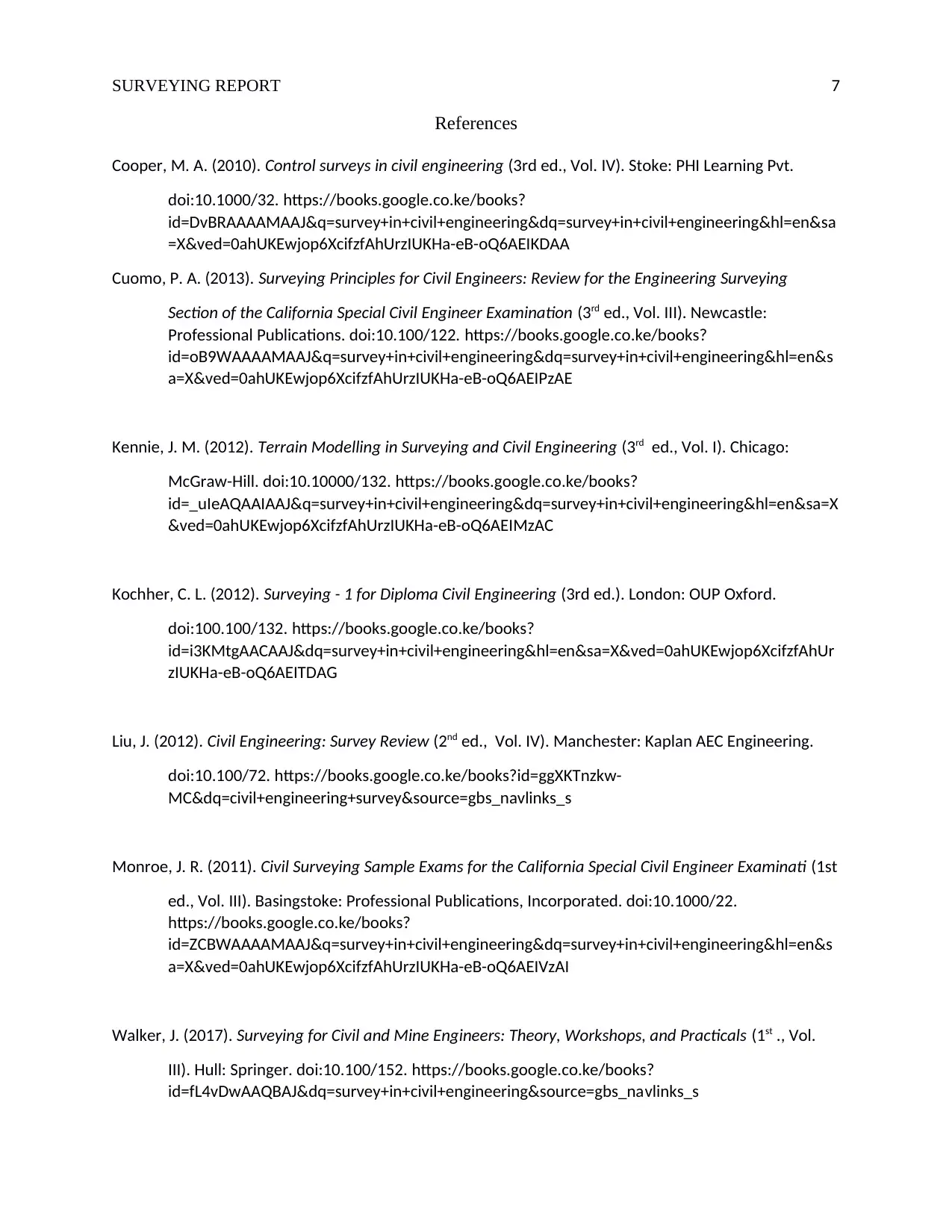
SURVEYING REPORT 7
References
Cooper, M. A. (2010). Control surveys in civil engineering (3rd ed., Vol. IV). Stoke: PHI Learning Pvt.
doi:10.1000/32. https://books.google.co.ke/books?
id=DvBRAAAAMAAJ&q=survey+in+civil+engineering&dq=survey+in+civil+engineering&hl=en&sa
=X&ved=0ahUKEwjop6XcifzfAhUrzIUKHa-eB-oQ6AEIKDAA
Cuomo, P. A. (2013). Surveying Principles for Civil Engineers: Review for the Engineering Surveying
Section of the California Special Civil Engineer Examination (3rd ed., Vol. III). Newcastle:
Professional Publications. doi:10.100/122. https://books.google.co.ke/books?
id=oB9WAAAAMAAJ&q=survey+in+civil+engineering&dq=survey+in+civil+engineering&hl=en&s
a=X&ved=0ahUKEwjop6XcifzfAhUrzIUKHa-eB-oQ6AEIPzAE
Kennie, J. M. (2012). Terrain Modelling in Surveying and Civil Engineering (3rd ed., Vol. I). Chicago:
McGraw-Hill. doi:10.10000/132. https://books.google.co.ke/books?
id=_uIeAQAAIAAJ&q=survey+in+civil+engineering&dq=survey+in+civil+engineering&hl=en&sa=X
&ved=0ahUKEwjop6XcifzfAhUrzIUKHa-eB-oQ6AEIMzAC
Kochher, C. L. (2012). Surveying - 1 for Diploma Civil Engineering (3rd ed.). London: OUP Oxford.
doi:100.100/132. https://books.google.co.ke/books?
id=i3KMtgAACAAJ&dq=survey+in+civil+engineering&hl=en&sa=X&ved=0ahUKEwjop6XcifzfAhUr
zIUKHa-eB-oQ6AEITDAG
Liu, J. (2012). Civil Engineering: Survey Review (2nd ed., Vol. IV). Manchester: Kaplan AEC Engineering.
doi:10.100/72. https://books.google.co.ke/books?id=ggXKTnzkw-
MC&dq=civil+engineering+survey&source=gbs_navlinks_s
Monroe, J. R. (2011). Civil Surveying Sample Exams for the California Special Civil Engineer Examinati (1st
ed., Vol. III). Basingstoke: Professional Publications, Incorporated. doi:10.1000/22.
https://books.google.co.ke/books?
id=ZCBWAAAAMAAJ&q=survey+in+civil+engineering&dq=survey+in+civil+engineering&hl=en&s
a=X&ved=0ahUKEwjop6XcifzfAhUrzIUKHa-eB-oQ6AEIVzAI
Walker, J. (2017). Surveying for Civil and Mine Engineers: Theory, Workshops, and Practicals (1st ., Vol.
III). Hull: Springer. doi:10.100/152. https://books.google.co.ke/books?
id=fL4vDwAAQBAJ&dq=survey+in+civil+engineering&source=gbs_navlinks_s
References
Cooper, M. A. (2010). Control surveys in civil engineering (3rd ed., Vol. IV). Stoke: PHI Learning Pvt.
doi:10.1000/32. https://books.google.co.ke/books?
id=DvBRAAAAMAAJ&q=survey+in+civil+engineering&dq=survey+in+civil+engineering&hl=en&sa
=X&ved=0ahUKEwjop6XcifzfAhUrzIUKHa-eB-oQ6AEIKDAA
Cuomo, P. A. (2013). Surveying Principles for Civil Engineers: Review for the Engineering Surveying
Section of the California Special Civil Engineer Examination (3rd ed., Vol. III). Newcastle:
Professional Publications. doi:10.100/122. https://books.google.co.ke/books?
id=oB9WAAAAMAAJ&q=survey+in+civil+engineering&dq=survey+in+civil+engineering&hl=en&s
a=X&ved=0ahUKEwjop6XcifzfAhUrzIUKHa-eB-oQ6AEIPzAE
Kennie, J. M. (2012). Terrain Modelling in Surveying and Civil Engineering (3rd ed., Vol. I). Chicago:
McGraw-Hill. doi:10.10000/132. https://books.google.co.ke/books?
id=_uIeAQAAIAAJ&q=survey+in+civil+engineering&dq=survey+in+civil+engineering&hl=en&sa=X
&ved=0ahUKEwjop6XcifzfAhUrzIUKHa-eB-oQ6AEIMzAC
Kochher, C. L. (2012). Surveying - 1 for Diploma Civil Engineering (3rd ed.). London: OUP Oxford.
doi:100.100/132. https://books.google.co.ke/books?
id=i3KMtgAACAAJ&dq=survey+in+civil+engineering&hl=en&sa=X&ved=0ahUKEwjop6XcifzfAhUr
zIUKHa-eB-oQ6AEITDAG
Liu, J. (2012). Civil Engineering: Survey Review (2nd ed., Vol. IV). Manchester: Kaplan AEC Engineering.
doi:10.100/72. https://books.google.co.ke/books?id=ggXKTnzkw-
MC&dq=civil+engineering+survey&source=gbs_navlinks_s
Monroe, J. R. (2011). Civil Surveying Sample Exams for the California Special Civil Engineer Examinati (1st
ed., Vol. III). Basingstoke: Professional Publications, Incorporated. doi:10.1000/22.
https://books.google.co.ke/books?
id=ZCBWAAAAMAAJ&q=survey+in+civil+engineering&dq=survey+in+civil+engineering&hl=en&s
a=X&ved=0ahUKEwjop6XcifzfAhUrzIUKHa-eB-oQ6AEIVzAI
Walker, J. (2017). Surveying for Civil and Mine Engineers: Theory, Workshops, and Practicals (1st ., Vol.
III). Hull: Springer. doi:10.100/152. https://books.google.co.ke/books?
id=fL4vDwAAQBAJ&dq=survey+in+civil+engineering&source=gbs_navlinks_s
Paraphrase This Document
Need a fresh take? Get an instant paraphrase of this document with our AI Paraphraser

SURVEYING REPORT 8
1 out of 8
Your All-in-One AI-Powered Toolkit for Academic Success.
+13062052269
info@desklib.com
Available 24*7 on WhatsApp / Email
![[object Object]](/_next/static/media/star-bottom.7253800d.svg)
Unlock your academic potential
Copyright © 2020–2025 A2Z Services. All Rights Reserved. Developed and managed by ZUCOL.